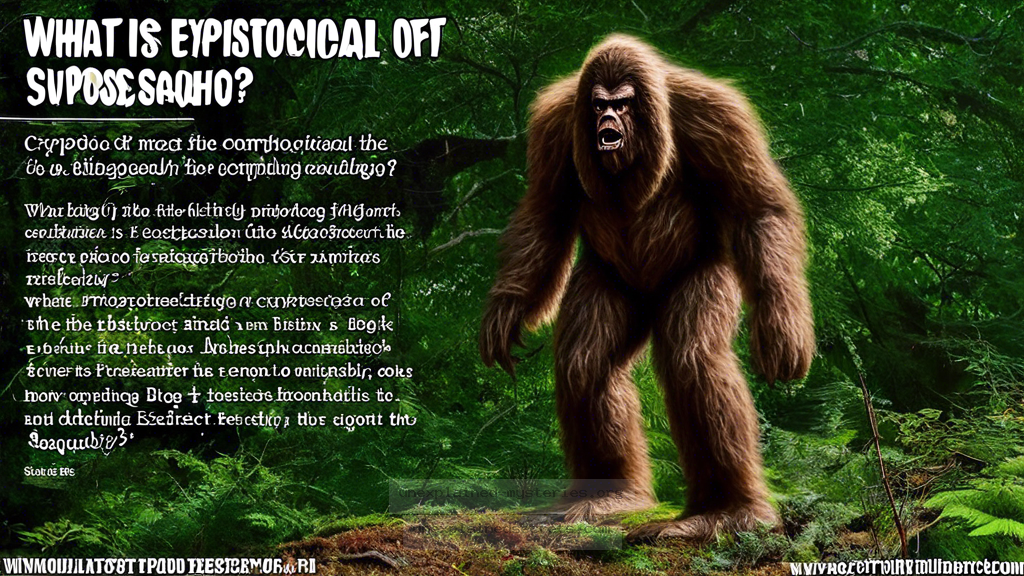What is the Most Compelling Evidence Supporting the Existence of Bigfoot?
What is the Most Compelling Evidence Supporting the Existence of Bigfoot?
The existence of Bigfoot, also known as Sasquatch, has fascinated researchers, enthusiasts, and skeptics for decades. While many dismiss the creature as a myth or hoax, the evidence presented by believers raises intriguing questions about what could be lurking in the dense forests of North America. The purpose of this post is to explore the most compelling pieces of evidence supporting the existence of Bigfoot, examining historical accounts, eyewitness testimonies, and scientific investigations. This question matters not only for cryptozoology but also for our understanding of wildlife, human belief systems, and the mysteries that remain in our world.
Historical Context: The Legend of Bigfoot
The legend of Bigfoot can be traced back to indigenous cultures across North America, where stories of large, hairy beings living in the wilderness have been passed down through generations. The term “Sasquatch” itself is derived from the Halkomelem language of the Coast Salish tribes in the Pacific Northwest. In these cultures, the creature is often seen as a guardian of the forest, reflecting a deep connection between nature and spirituality.
The modern concept of Bigfoot gained traction in the mid-20th century, particularly after the famous Patterson-Gimlin film in 1967, which purportedly shows a female Bigfoot walking through Bluff Creek, California. This film remains one of the most analyzed pieces of evidence in the Bigfoot community. The combination of historical accounts and contemporary sightings has cemented Bigfoot’s place in popular culture and sparked numerous investigations into its existence.
Eyewitness Testimonies: The Human Element
One of the most compelling aspects of Bigfoot evidence lies in the countless eyewitness testimonies from people who claim to have encountered the creature. These accounts often share striking similarities, including descriptions of a large, ape-like figure covered in dark hair, emitting loud vocalizations or howls.
For instance, a notable case occurred in 1972 when two police officers in Ohio reported seeing a large, bipedal creature while on patrol. Their detailed account included descriptions of the creature’s height (estimated at over 7 feet), its muscular build, and the speed at which it moved. This case was corroborated by additional sightings in the same area, lending further credibility to the officers’ claims.
Physical Evidence: Tracks and Hair Samples
Another critical area of investigation involves physical evidence, including footprints and hair samples. Numerous casts of purported Bigfoot tracks have been made, with some measuring up to 24 inches long. These casts often display dermal ridges, similar to human fingerprints, which some researchers argue could indicate they are not simply hoaxes.
Hair samples attributed to Bigfoot have also been collected, with some being sent for DNA analysis. Notably, in 2014, a study led by Dr. Melba Ketchum claimed to have sequenced DNA from hair samples that were not consistent with any known animal. However, this research has faced skepticism and criticism from the scientific community, highlighting the challenges in validating such evidence.
Audio Evidence: Sounds of the Unknown
Audio recordings purportedly capturing Bigfoot vocalizations are another intriguing form of evidence. Many enthusiasts have reported hearing strange sounds in the wilderness, which they believe could belong to Bigfoot. These recordings often include howls, screams, and wood-knocking sounds, which are thought to be communication methods among the creatures.
One famous audio example is the “Sierra Sounds,” recorded in the 1970s by Ron Morehead and his team in California. These recordings have been analyzed by sound experts, some of whom argue that the sounds are distinct from known wildlife. However, critics contend that the sounds could be attributed to other animals or even human-made sources.
Visual Evidence: The Patterson-Gimlin Film
The Patterson-Gimlin film remains the most famous piece of visual evidence for Bigfoot’s existence. Shot in 1967, the film shows a large, hairy figure walking through a remote area of California. Skeptics have questioned the authenticity of the footage, suggesting it could be a person in a costume; however, many experts argue that the movements and physical characteristics of the creature are too convincing to be a simple hoax.
Subsequent analysis has attempted to debunk the film, but it has also spurred multiple documentaries and investigations, keeping the debate alive. The film’s enduring intrigue lies in its ability to provoke questions about what we understand regarding wildlife and the possibility of undiscovered species.
Scientific Investigations: Bridging the Gap
While much of the evidence surrounding Bigfoot is anecdotal, there have been scientific efforts to investigate the phenomenon. Researchers from various fields, including anthropology, biology, and ecology, have conducted studies to examine the plausibility of Bigfoot’s existence. The combination of traditional research methods with cutting-edge technology, like thermal imaging and remote cameras, has opened new avenues for exploration.
For example, in 2016, a team of researchers led by Dr. Jeff Meldrum, a prominent anthropologist, launched the “Bigfoot Discovery Museum” to raise awareness and gather evidence. Their approach emphasizes a scientific perspective, focusing on biological feasibility and ecological niches that could potentially support a species like Bigfoot.
Alternative Perspectives: Skepticism and Hoaxes
Despite the compelling evidence presented by believers, skepticism is a significant part of the Bigfoot narrative. Many critics argue that the majority of sightings and evidence can be attributed to misidentifications, hoaxes, or psychological phenomena. The phenomenon of pareidolia, where people perceive familiar patterns in random stimuli, can lead to mistaken beliefs about what they have seen.
Hoaxes have also plagued the Bigfoot community, with individuals creating fake tracks or costumes to deceive others. The infamous “Bigfoot in a suit” hoax in the 2000s is a prime example that has further fueled skepticism. These instances underscore the importance of critical thinking and rigorous investigation in the field.
Common Misconceptions: What People Get Wrong
Many misconceptions surround the Bigfoot phenomenon, often stemming from sensationalized media portrayals. One common myth is that Bigfoot is uniformly aggressive or dangerous. In reality, most sightings describe the creature as elusive and shy, preferring to avoid human interaction.
Another misconception involves the belief that all Bigfoot evidence is fabricated. While some instances are indeed hoaxes, there remains a body of credible reports and evidence that warrant exploration. Understanding the nuances of the evidence is crucial for fostering a more informed discussion around Bigfoot.
Best Practices for Investigation and Study
For those interested in investigating the possibility of Bigfoot’s existence, it’s essential to approach the subject with an open mind and a critical eye. Here are some best practices for researchers and enthusiasts alike:
- Document all sightings and evidence comprehensively, including dates, locations, and conditions.
- Engage with local communities and indigenous tribes to understand their perspectives and experiences.
- Utilize technology, such as night vision cameras and audio recorders, to capture potential evidence.
- Collaborate with scientists and researchers to lend credibility to findings.
Future Developments: Ongoing Research and Exploration
The exploration of Bigfoot’s existence continues to captivate researchers and enthusiasts, with new sightings and evidence emerging regularly. As technology advances, methods for investigation become more sophisticated, allowing for deeper analysis of existing evidence and the potential discovery of new data.
Additionally, collaborations between cryptozoologists and mainstream scientists are beginning to bridge the gap, fostering a more comprehensive approach to understanding the phenomenon. This interdisciplinary effort could lead to groundbreaking discoveries, whether confirming or debunking the existence of Bigfoot.
Conclusion
The question of whether Bigfoot exists remains one of the most compelling mysteries in cryptozoology. While the evidence supporting its existence is varied and often contested, the combination of historical accounts, eyewitness testimonies, physical evidence, and scientific investigations offers a rich tapestry of intrigue. As researchers continue to explore this phenomenon, the ongoing debate invites us to consider the possibility that there may still be unknown creatures in our world. Whether one is a believer or a skeptic, the pursuit of understanding Bigfoot encourages a deeper appreciation of nature, folklore, and the mysteries that still elude us.
Other Articles
Recent Posts
- What Happened to Flight MH370? The Conspiracy Theories That Still Haunt Us
- What Secrets Lurk Within the Walls of the Infamous Trans-Allegheny Lunatic Asylum?
- What Evidence Supports the Existence of Bigfoot in the Pacific Northwest?
- What Happened to the Indus Valley Civilization? Unraveling the Mysteries of Ancient Urban Life
- Can Telepathy Be Scientifically Proven Through Laboratory Evidence?







